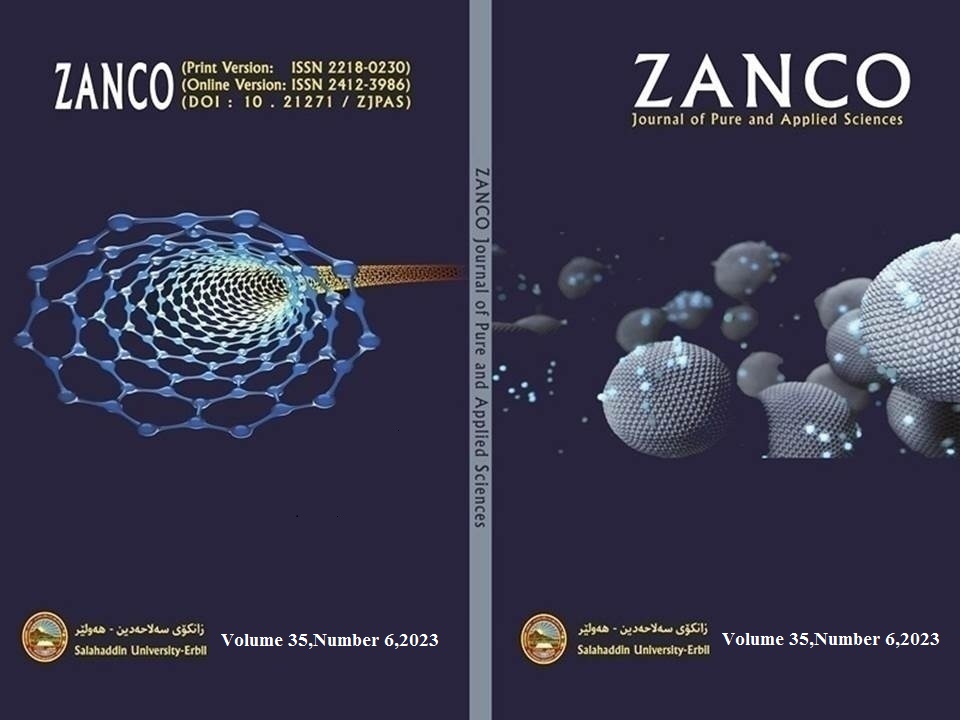Multi-sensor Satellite Drought Analysis using Landsat and MODIS Time-Series Based on NDVI and Rainfall
DOI:
https://doi.org/10.21271/ZJPAS.35.6.20Keywords:
Climate conditions, Drought; NDVI, and Rainfall Anomaly.Abstract
Iraq's climate is prone to frequent droughts, which have severely influenced the country in the past two decades. A study conducted using remote sensing and geographical information systems analyzed the spatiotemporal patterns of drought in Iraqi Kurdistan - specifically Erbil for 19 years from 2003 to 2021. The research found that the region had experienced severe drought episodes during this time, with an increase in severity and frequency, especially in 2008, 2012, and 2021. These years were noticeable by a decrease in vegetation area cover and lower average precipitation. The study utilized the Normalized Difference Vegetation Index (NDVI), Rainfall, and Rainfall Anomaly to produce multi-temporal classified drought maps, which showed that climate conditions played a significant role in the change of the vegetated cover area. The research also estimated the effect of rainfall variability on vegetation cover in Erbil, concluding that rainfall anomalies led to changes in the NDVI. The correlation matrix between rainfall anomalies and NDVI anomalies confirms that irregular rainfall patterns result in modifications to the NDVI. Productivity was found to increase with wet anomalies and decrease with dry anomalies. Overall, the study provides valuable insights into the impact of drought on agricultural productivity in the Iraqi Kurdistan Region (IKR)-Erbil and emphasizes the importance of implementing effective strategies to mitigate the impact of drought on agriculture in the region.
References
AADHAR, S., MISHRA, V., 2017. Data Descriptor: High-resolution near real-time drought monitoring in South Asia. Sci. Data 4, 1–14.
ABDEL-HAMID, A., DUBOVYK, O., GRAW, V., GREVE, K., 2020. Assessing the impact of drought stress on grasslands using multi-temporal SAR data of Sentinel-1: a case study in Eastern Cape, South Africa. Eur. J. Remote Sens. 00, 1–14.
AKBAR, T.A., HASSAN, Q.K., ISHAQ, S., BATOOL, M., BUTT, H.J., JABBAR, H., 2019. Investigative spatial distribution and modelling of existing and future urban land changes and its impact on urbanization and economy. Remote Sens. 11.
AL-QURAISHI, A., RAZVANCHY, H., GAZNAYEE, H.A.A., 2020. A Comparative Study for Performance of Five Landsat-based Vegetation Indices: Their Relations to Some Ecological and Terrain Variables. J. Geoinformatics Environ. Res. 1, 20–37.
AL-QURAISHI, A.M.F., 2019. Combination : Drought Monitoring Using Spectral and Meteorological Based Indices Combination: A Case Study in Sulaimaniyah, Kurdistan Region of Iraq 377–393.
AL-QURAISHI, A.M.F., GAZNAYEE, H.A.A, CRESPI, M., 2021. Drought trend analysis in a semi-arid area of Iraq based on Normalized Difference Vegetation Index, Normalized Difference Water Index and Standardized Precipitation Index. J. Arid Land 13, 413–430.
AL-SHWANI, F.M.A., 2009. Land cover change detection in Erbil governorate using remote sensing techniques.
ALMAMALACHY, Y.S., AL-QURAISHI, A.M.F., MORADKHANI, H., 2019. Iraq Utilizing MODIS Products.
AMRI, R., ZRIBI, M., LILI-CHABAANE, Z., DUCHEMIN, B., GRUHIER, C., CHEHBOUNI, A., 2011. Analysis of vegetation behavior in a North African semi-arid region, Using SPOT-VEGETATION NDVI data. Remote Sens. 3, 2568–2590.
ANDRIEU, J., 2017. Phenological analysis of the savanna–forest transition from 1981 to 2006 from Côte d’Ivoire to Benin with NDVI NOAA time series. Eur. J. Remote Sens. 50, 588–600.
ANYAMBA, A., TUCKER, C.J., 2001. NDVI anomaly patterns over Africa during the 1997/98 ENSO warm event. Int. J. Remote Sens. 22, 1847–1859.
ANYAMBA, A., TUCKER, C.J., 2012. Historical perspectives on AVHRR NDVI and vegetation drought monitoring. Remote Sens. Drought Innov. Monit. Approaches 23–49.
AWCHI, T.A., JASIM, A.I., 2017. Rainfall Data Analysis and Study of Meteorological Draught in Iraq for the Period 1970-2010. Tikrit J. Eng. Sci. 24, 110–121.
BABBIE, ERR., 2009. The Practice of Social Research. 12th edition, Wadsworth Publishing, 2009, ISBN 0-495-59841-0, pp. 436–440.
BEZDAN, J., BEZDAN, A., BLAGOJEVIĆ, B., MESAROŠ, M., PEJIĆ, B., VRANEŠEVIĆ, M., PAVIĆ, D., NIKOLIĆ-ĐORIĆ, E., 2019. SPEI-Based Approach to Agricultural Drought Monitoring in Vojvodina Region. Water 11, 1481.
DUBOVYK, O., 2017. The role of Remote Sensing in land degradation assessments: opportunities and challenges. Eur. J. Remote Sens. 50, 601–613.
DUTTA, D., KUNDU, A., PATEL, N.R., SAHA, S.K., SIDDIQUI, A.R., 2015A. Assessment of agricultural drought in Rajasthan (India) using remote sensing derived Vegetation Condition Index (VCI) and Standardized Precipitation Index (SPI). Egypt. J. Remote Sens. Sp. Sci. 18, 53–63.
DUTTA, D., KUNDU, A., PATEL, N.R., SAHA, S.K., SIDDIQUI, A.R., 2015B. Assessment of agricultural drought in Rajasthan (India) using remote sensing derived Vegetation Condition Index (VCI) and Standardized Precipitation Index (SPI). Egypt. J. Remote Sens. Sp. Sci. 18, 53–63.
FADHIL, A.M., 2011. Drought mapping using Geoinformation technology for some sites in the Iraqi Kurdistan region. Int. J. Digit. Earth 4, 239–257.
FUNK, C., PETERSON, P., LANDSFELD, M., PEDREROS, D., VERDIN, J., SHUKLA, S., HUSAK, G., ROWLAND, J., HARRISON, L., HOELL, A., MICHAELSEN, J., 2015. The climate hazards infrared precipitation with stations - A new environmental record for monitoring extremes. Sci. Data 2, 1–21.
GAZNAYEE, H.A.A., 2020. Modeling Spatio-Temporal Pattern of Drought Severity Using Meteorological Data and Geoinformatics Techniques for the Kurdistan Region of Iraq. Dissertation 1–11.
GAZNAYEE, H.A. A, AL-QURAISHI, A.M.F., MAHDI, K., MESSINA, J.P., ZAKI, S.H., RAZVANCHY, H.A.S., HAKZI, K., HUEBNER, L., ABABAKR, S.H., RIKSEN, M., RITSEMA, C., 2022. Drought Severity and Frequency Analysis Aided by Spectral and Meteorological Indices in the Kurdistan Region of Iraq. Water 14, 1–29.
GAZNAYEE, H.A.A., AL-QURAISHI, A.M.F., MAHDI, K., RITSEMA, C., 2022. A Geospatial Approach for Analysis of Drought Impacts on Vegetation Cover and Land Surface Temperature in the Kurdistan Region of Iraq. Water 14, 927.
HARUN, R., MURESAN, I.C., ARION, F.H., DUMITRAS, D.E., LILE, R., 2015. Analysis of factors that influence the willingness to pay for irrigation water in the Kurdistan Regional Government, Iraq. Sustain. 7, 9574–9586.
HEYDARI, H., ZOEJ, M.J.V., MAGHSOUDI, Y., DEHNAVI, S., 2018. An investigation of drought prediction using various remote-sensing vegetation indices for different time spans. Int. J. Remote Sens. 39, 1871–1889.
HAKZI KAWA. K., , A., 2022. Spatiotemporal variation of wheat yield and water productivity in centre pivot irrigation systems.
KEYANTASH, J.A., DRACUP, J.A., 2004. An aggregate drought index: Assessing drought severity based on fluctuations in the hydrologic cycle and surface water storage. Water Resour. Res. 40, 1–14.
LLOYD-HUGHES, B., 2014. The impracticality of a universal drought definition. Theor. Appl. Climatol. 117, 607–611.
MOHAMMED, R., SCHOLZ, M., 2017. Adaptation Strategy to Mitigate the Impact of Climate Change on Water Resources in Arid and Semi-Arid Regions: a Case Study. Water Resour. Manag. 31, 3557–3573.
MZURI, R.T., MUSTAFA, Y.T., OMAR, A.A., 2021. Land degradation assessment using AHP and GIS-based modelling in Duhok District, Kurdistan Region, Iraq. Geocarto Int. 0, 1–19.
OWRANGI, M.A., ADAMOWSKI, J., RAHNEMAEI, M., MOHAMMADZADEH, A., SHARIFAN, R.A., 2011. Drought Monitoring Methodology Based on AVHRR Images and SPOT Vegetation Maps. J. Water Resour. Prot. 03, 325–334.
PEREZ, G.J., MACAPAGAL, M., OLIVARES, R., MACAPAGAL, E.M., COMISO, J.C., 2016. Forecasting and monitoring agricultural drought in the Philippines. Int. Arch. Photogramm. Remote Sens. Spat. Inf. Sci. - ISPRS Arch. 41, 1263–1269.
RAZVANCHY, H.A.S., FAYYADH, M.A., 2022. GIS and AHP Based Techniques for Agricultural Land Suitability Assessment in Erbil Province, Kurdistan region, Iraq. Basrah J. Agric. Sci. 35, 140–157.
SAEED, M.A., 2012. Analysis of Climate and Drought Conditions in the Fedral. Journal, Int. Sci. Sci. Environ. 953.
SALEHNIA, N., ALIZADEH, A., SANAEINEJAD, H., BANNAYAN, M., ZARRIN, A., HOOGENBOOM, G., 2017. Estimation of meteorological drought indices based on AgMERRA precipitation data and station-observed precipitation data. J. Arid Land 9, 797–809.
SCHUCKNECHT, A., ERASMI, S., NIEMEYER, I., MATSCHULLAT, J., 2013. Assessing vegetation variability and trends in north-eastern Brazil using AVHRR and MODIS NDVI time series. Eur. J. Remote Sens. 46, 40–59.
SCIENCE, E., SUBMITTED, T., SENSING, R., 2010. Agricutltural Drought Assessment Using Remote Sensing and Gis Techinques Agricutltural Drought Assessment Using Remote. System.
SHAMSIPOUR, A.A., ZAWAR-REZA, P., PANAH, S.K.A., AZIZI, G., 2011. Analysis of drought events for the semi-arid central plains of Iran with satellite and meteorological based indicators. Int. J. Remote Sens. 32, 9559–9569.
SRUTHI, S., ASLAM, M.A.M., 2015. Agricultural Drought Analysis Using the NDVI and Land Surface Temperature Data; a Case Study of Raichur District. Aquat. Procedia 4, 1258–1264.
UNESCO, 2009. Survey of Infiltration Karez in Northern Iraq: History and Current Status of Underground Aqueducts A report prepared for UNESCO 56.
UNESCO, 2014. Integrated drought risk management– DRM executive. Natl. Framew. IRAQ AN Anal. Rep. MARcH Second edi.
VICENTE-SERRANO, S.M., BEGUERÍA, S., LÓPEZ-MORENO, J.I., 2010. A multiscalar drought index sensitive to global warming: The standardized precipitation evapotranspiration index. J. Clim. 23, 1696–1718.
WAN, Z., WANG, P., 2004. International Journal of Remote Using MODIS Land Surface Temperature and Normalized Difference Vegetation Index products for monitoring drought in the southern Great Plains , USA 37–41.
WU, W., MUHAIMEED, A.S., AL-SHAFIE, W.M., AL-QURAISHI, A.M.F., 2019. Using L-band radar data for soil salinity mapping — a case study in Central Iraq. Environ. Res. Commun.
YAN, G., LIU, Y., CHEN, X., 2018. Evaluating satellite-based precipitation products in monitoring drought events in southwest China. Int. J. Remote Sens. 39, 3186–3214.
YANG, J., WANG, Y.Q., SUN, Z., WANG, Q.Q., 2016. Mapping Drought Hazard Using SPI index And GIS (A Case study: Fars province, Iran). Remote Sens. Environ. 7, 1–4.
YAO, Y., QIN, Q., FADHIL, A.M., LI, Y., ZHAO, S., LIU, S., SUI, X., DONG, H., 2011. Evaluation of EDI derived from the exponential evapotranspiration model for monitoring China’s surface drought. Environ. Earth Sci. 63, 425–436.
ZEWDIE, W., CSAPLOVICS, E., 2015. Remote sensing based multi-temporal land cover classification and change detection in northwestern ethiopia. Eur. J. Remote Sens. 48, 121–139.
Downloads
Published
How to Cite
Issue
Section
License
Copyright (c) 2023 Sara Hayman Zaki, Heman Abdulkhaleq A. Gaznayee, Payam Salah Hawez

This work is licensed under a Creative Commons Attribution 4.0 International License.














